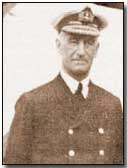Who's Who - Sir John de Robeck
 Admiral Sir John Michael De Robeck
(1862-1928) oversaw the disastrous initial attempt to capture the
Dardanelles Straits in March 1915.
Admiral Sir John Michael De Robeck
(1862-1928) oversaw the disastrous initial attempt to capture the
Dardanelles Straits in March 1915.
De Robeck entered the navy in 1875 and had reached the rank of Rear-Admiral three years before war broke out in 1914. With the declaration of war de Robeck was given command of the 9th Cruiser Squadron before being appointed deputy to Admiral Sackville Carden at the East Mediterranean Squadron tasked with the Dardanelles expedition.
Illness however obliged Carden to give up his post, and de Robeck consequently led the disastrously unsuccessful attempt upon the Straits on 18 March 1915 (chiefly on account of the presence of an unsuspected Turkish minefield), the more senior Admiral Rosslyn Wemyss having stepped aside to allow de Robeck to oversee the operation.
Five Allied warships were sunk or disabled by mines during the operation: the British Inflexible, Irresistible and Ocean; and the French Bouvet and Gaulois.
Distraught by the experience de Robeck promptly insisted that no further attempt be made until ground troops had been landed and given time to capture the high ground around the Narrows. He maintained this view even under heavy pressure from such political heavyweights as Winston Churchill, the First Lord of the Admiralty, and his own fiery Chief of Staff Roger Keyes, refusing to countenance a further attack which he believed would inevitably fail at heavy cost.
As a consequence of de Robeck's stance he came under sustained criticism from those who felt that he had in effect doomed the whole Dardanelles campaign to failure. Sir Ian Hamilton, Commander-in-Chief of the Mediterranean Expeditionary Force, subsequently agreed however to attempt to capture land dominating the Narrows in a meeting held with de Robeck four days after the failed attack.
Having earned praise for his role in assisting the evacuation of Gallipoli towards the end of 1915 De Robeck saw out the remainder of the war in command of the Grand Fleet's 2nd Battle Squadron from December 1916-19, having been promoted to Vice-Admiral.
From 1919-20 he served as High Commissioner at Constantinople, and from 1922-24 he was commander of the Atlantic Fleet.
He died in 1928.
Shrapnel comprised steel balls ejected from shells upon detonation.
- Did you know?
